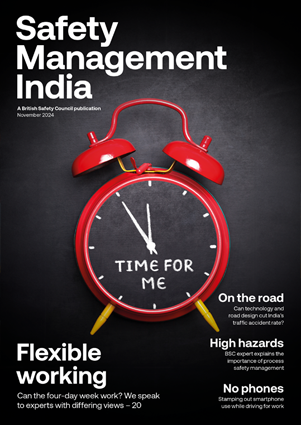Employers have a legal duty to protect outdoor workers from the harmful effects of sun exposure, and should begin by educating staff about the dangers.
Features
Outdoor workers and UV: your responsibilities as an employer
As an employer, it is your responsibility to educate your workforce about the importance of UV protection and to encourage them to follow best practice. With summer quickly approaching, it’s imperative for your workers to know about the associated health risks and to ensure access to suitable sun protection products.
Ultraviolet (UV) rays from the sun can provide us with numerous benefits¹, but research has shown that prolonged exposure can lead to serious skin damage². Worryingly, a third (34 per cent) of outdoor workers have expressed that nothing would convince them to begin taking protective measures³. This illustrates how important it is for you to be aware of the risks surrounding UV rays and to take subsequent action to help safeguard your workforce.
 Photograph: SC Johnson Professional
Photograph: SC Johnson Professional
Understanding the attitudes of outdoor workers is crucial in addressing the issue of UV protection neglect. Many workers cite a lack of belief in the necessity of protection, with 28 per cent claiming they don’t easily burn in the sun⁴ – ultimately leading them to forgo UV protection measures. However, research from SC Johnson Professional shows that educating workers about the effects of UV damage can significantly influence their behaviour. This is underscored by the fact that nearly two-thirds (61 per cent) of those who work outdoors agree that understanding the effects of UV damage encourages them to use sun protection cream at work⁵. With this in mind, it is crucial for you, as an employer, to recognise your pivotal role in shaping attitudes towards UV protection in the workplace.
The importance of legislation
Understanding the legal framework surrounding UV protection in the workplace is crucial when it comes to your compliance with regulations around employee safety and health.
The Health and Safety at Work Act states that there is a legal duty on every employer to ensure, as far as reasonably practicable, the health of their employees⁶. The Management of Health and Work Regulations also requires the employer to conduct a suitable assessment of the risks to the health of their workforce, including the risks from UV radiation⁷.
Failing to provide adequate UV protection can not only jeopardise employee health, but may also expose you to serious consequences when it comes to worker safety.
To fulfil your obligations as an employer and help promote a safe working environment, you must prioritise UV protection measures. Addressing these regulations not only ensures compliance, but also helps to foster healthier and safer workplaces for all employees.
Keeping employees protected
Encouraging your employees to protect their skin year-round is vital. Outdoor workers should opt for a sun protection product with the following; broad-spectrum coverage, a high sun protection factor (at least SPF 30), and protection against UVA and UVB rays.
Some sun protection creams have also been specifically developed to help limit the effect on dexterity with hand-held tools, therefore ensuring a non-greasy after-feel once they have been applied to the skin.
Applying these products to clean, dry skin about 15–20 minutes before sun exposure and reapplying every two hours is key. For optimal coverage, you should suggest using half a teaspoon for the face and at least six full teaspoons for the body.
How to implement UV protection measures
As an employer, you play a crucial role in helping to mitigate the risks of sun exposure and protecting your workforce. Firstly, providing appropriate personal protective equipment (PPE), including UV protection cream, is essential. Moreover, offering comprehensive training sessions on the risks of sun exposure and methods for protection raises awareness among workers. Educating your employees about early symptoms of heat stress and proper heat stress management is also vital for their wellbeing.
Additionally, the Health and Safety Executive recommends some practical measures to reduce sun exposure during peak hours. This can include rescheduling work to cooler times of the day, providing more frequent rest breaks and introducing shading to rest areas. Offering free access to cool drinking water and encouraging workers to remove PPE during breaks further aids in heat management. By taking these proactive steps, you not only ensure the immediate safety and comfort of your workforce, but also help mitigate the long-term risks associated with excessive sunlight exposure⁸.
By providing good quality sun protection cream when and where it is needed, such as at workplace entrances and exits and in outdoor areas, you can further help to fulfil your duty of care and raise awareness of the risks of over-exposure to the sun among workers. This is backed up by research, which reveals that 16 per cent of workers who do not use sun protection cite its absence in their workplace as the reason⁹.
By fostering a culture of awareness surrounding UV protection, you can help create an environment where sun safety is prioritised, encouraging your employees to make informed decisions about their health and safety while on the job. Through these initiatives, employers can demonstrate their commitment to employee wellbeing, help mitigate the risks posed by UV radiation, and contribute to creating a safe and healthy workplace for all.
SC Johnson Professional has a suite of free resources that can be used to train employees who work outdoors, and for health and safety professionals to implement as part of a skincare training programme. The resource pack includes a guide for outdoor workers, posters to raise awareness and a toolbox talk presentation. The presentation can help managers to deliver quality, informative training, and includes videos that illustrate real-life case studies and simple facts to bring home the reality of over-exposure.
Find out more about SC Johnson Professional’s resources and product range at:
scjp.com/en-gb/whats-new/campaigns/uv-sun-protection
References:
- scjp.com/en-gb/whats-new/campaigns/uv-sun-protection
- scjp.com/en-gb/whats-new/campaigns/uv-sun-protection
- A YouGov survey commissioned in April 2023 by at-work skin care, cleaning & hygiene solutions provider SC Johnson Professional
- SC Johnson Professional’s 2020 survey of 114 UK health and safety officials
- A YouGov survey commissioned in April 2023 by at-work skin care, cleaning & hygiene solutions provider SC Johnson Professional
- hse.gov.uk/pubns/indg244.PDF
- legislation.gov.uk/uksi/1999/3242/regulation/3/made
- hse.gov.uk/temperature/employer/outdoor-working.htm
- Survey conducted by YouGov Plc. Total sample size was 4435 adults, of whom 558 were outdoor workers. Fieldwork was undertaken between 14 and 18 April 2023. The survey was carried out online. The figures have been weighted and are representative of all UK adults aged 18+.


FEATURES
Why changes to recycling legislation in England are an opportunity, not a burden
By on 12 November 2024

Road safety in India: could better road safety, vehicle technology and enforcement make driving for work safer?
By Orchie Bandyopadhyay on 10 November 2024
India has a poor road safety record, and research shows that commercial vehicles are a major contributor to the problem, with trucks estimated to be the single largest vehicle type involved in impacts leading to fatalities. We look at solutions that could make driving for work and the roads in general safer – from in-vehicle technology that warns truck drivers about unsafe behaviour to improving the design features of major highways.

